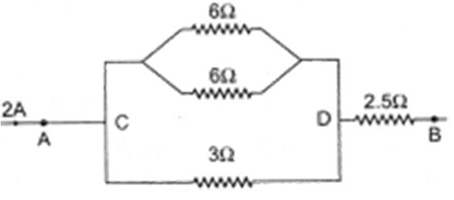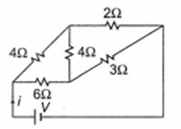 Multiple Choice Questions
Multiple Choice QuestionsTwo equal resistances R are joined with voltage source V in (i)series (ii)parallel, the ratio of electrical power consumed in two cases will be
1:4
4:1
2:1
1:2
When a resistance of α Ω is connected at the ends of a battery, its potential difference decreases from 40 V to 30V. The internal resistance of the battery is
3Ω
6Ω
1.5Ω
4Ω
The equivalent resistance and potential difference between A and B for the circuit
respectively are

4Ω, 8V
8Ω, 4V
2Ω, 2V
16Ω, 2V
A wire of resistance R is divided in equal parts, then these parts are joined in parallel, the equivalent resistance of the combination will be
nR
When a certain current is passed in the circuit as shown in figure, 10 kcal of heat is produced in 5 Ω resistance. How much heat is produced in 4 Ω resistance?

4 kcal
2 kcal
5 kcal
3 kcal
In the given circuit, what will be the equivalent resistance between the points A and B ?

10 / 3 Ω
20 / 3 Ω
10 / 5 Ω
5 Ω
A uniform wire of length I and having resistance R is cut into n equal parts and all parts are connected in parallel, then the equivalent resistance will be :
R
R/n
R/n2
n2R
For the network shown in the figure, the value of the current i is

B.
The circuit given resembles the balanced Wheatstone Bridge as
Thus, a middle arm containing 4 Ω resistance will be ineffective and no current flows through it. The equivalent circuit is shown as below:

Net resistance of AB and BC
R' = 4 + 2 = 6 Ω
Net resistance of AD and DC
R'' = 6 + 3 = 9 Ω
Thus parallel combination of R' and R'' gives
When a wire of uniform cross-section a, length land resistance R is bent into a complete circle, resistance between two of dimetrically opposite points will be
4R
